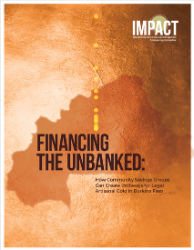
Financing the Unbanked: How Community Savings Groups Can Create Pathways for Legal Artisanal Gold in Burkina Faso
March 2023
IMPACT explores the role of financing to support formalization and end the illicit gold trade. The report examines the case of Burkina Faso’s artisanal gold mining sector, but findings can be applied to contexts worldwide.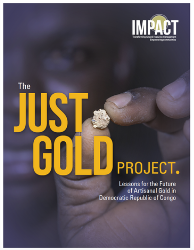
The Just Gold Project: Lessons for the Future of Artisanal Gold in Democratic Republic of Congo
March 2021
Read about IMPACT’s experiences and lessons learned from implementing the Just Gold project in Democratic Republic of Congo from 2012 to 2020.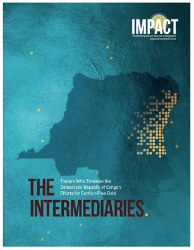
The Intermediaries: Traders Who Threaten the Democratic Republic of Congo’s Efforts for Conflict-Free Gold
September 2020
IMPACT documents how registered traders and exporters in DRC, Rwanda, and Uganda provide a sheen of legality by declaring a small percentage of their gold exports while pocketing massive profits from the illicit trade. They thwart attempts to disrupt their scheme by reconfiguring their operations across the region when necessary or by creating phantom entities.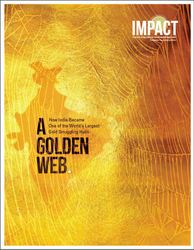
A Golden Web: How India Became One of the World’s Largest Gold Smuggling Hubs
November 2019
IMPACT’s new report reveals India to be one of the largest gold smuggling hubs in the world. As a result, gold that is tied to conflict, human rights abuses, and corruption in Africa and South America is entering legal international markets through India.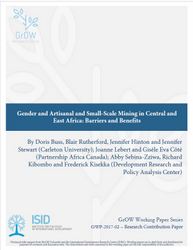
Gender and Artisanal and Small-Scale Mining in Central and East Africa: Barriers and Benefits
July 2017
This working paper presents key research findings on women in the artisanal mining sector in the Great Lakes region. It was developed by Partnership Africa Canada, Carleton University and Development Research and Social Policy Analysis Center (DRASPAC) as part of the GrOW program.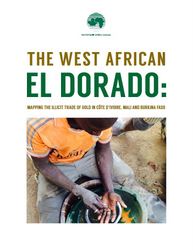
The West African El Dorado: Mapping the Illicit Trade of Gold in Côte d'Ivoire, Mali and Burkina Faso
January 2017
Partnership Africa Canada investigates challenges in the governance of artisanal gold mining in the three countries—and the vulnerabilities posed by the illicit trade of gold on the region.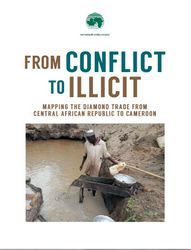
From Conflict to Illicit: Mapping the Diamond Trade from Central African Republic to Cameroon
December 2016
Partnership Africa Canada investigates how conflict diamonds from the Central African Republic are entering international markets through Cameroon. The report details how Cameroon's failure to implement internal controls required by the Kimberley Process has led to smuggling of diamonds from CAR, corruption among officials charged with verifying origins of diamonds, and large shipments of embargoed conflict diamonds passing through Cameroon's transit hubs undeclared.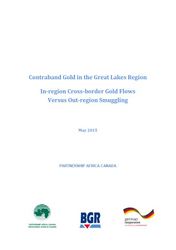
Contraband Gold in the Great Lakes Region: In-region Cross-border Gold Flows Versus Out-region Smuggling
May 2015
This report analyzes the artisanal gold flows within and out of the Great Lakes Region with the perspective of promoting responsible supply chain management in the context of the ICGLR Regional Initiative on Natural Resources and the OECD Due Diligence Guidance.
Women in the Artisanal Gold Mining Sector in the Democratic Republic of Congo
November 2014
Key findings from field research aimed at understanding the roles women play in artisanal gold mining in Democratic Republic of Congo. The research seeks to identify how the informal nature of the gold trade amplifies women’s vulnerabilities, as well as how the introductions of formalization and certification mechanisms could either present new opportunities or further contribute to their marginalization.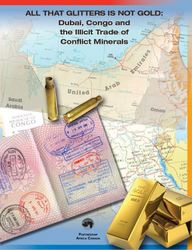
All That Glitters is Not Gold: Dubai, Congo, and the Illicit Trade of Conflict Minerals
May 2014
This report is a contribution to a growing body of research that seeks to better understand the illicit trade of gold and diamonds emanating from the Democratic Republic of Congo, and the role industry and state actors play - primarily in neighbouring countries and the United Arab Emirates - in facilitating this illegality.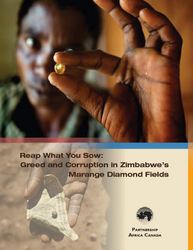
Reap What You Sow: Greed and Corruption in Zimbabwe’s Marange Diamond Fields
November 2012
The third investigation by PAC into illicit activity in Zimbabwe’s diamond sector, this report focusses on ongoing trade irregularities, the lack of transparency of diamond revenues, and examines ways ZANU officials and the global diamond industry have colluded to pull off the biggest plunder of diamonds since Cecil Rhodes. It also examines the various revenue streams of Zimbabwe’s Minister of Mines and concludes he is utilizing monies and assets divorced from his ministerial salary and known business entities. The report offers policy suggestions and recommendations that would improve the management and public beneficiation of Zimbabwe’s diamond revenues.
Taming the Resource Curse: Implementing the ICGLR Certification Mechanism for Conflict-prone Minerals
May 2011
This report prepared by PAC for the ICGLR and released in March 2011, describes the regional certification mechanism (RCM) for tracking high value and conflict prone minerals in Africa’s Great Lakes region. Based on lessons learned from other certification mechanisms, particularly the Kimberley Process, it promotes key principles that will make for a stronger and more effective regulatory scheme for four minerals—namely gold, coltan, tungsten and tin.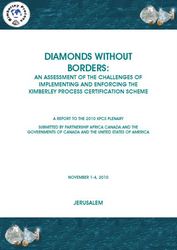
Diamonds Without Borders: An Assessment of the Challenges of Implementing and Enforcing the KP Certification Scheme
November 2010
In 2010, Israel (the Chair of the KPCS) prioritized strengthening KPCS efforts to combat diamond smuggling. In support of this priority, PAC worked with Israel, Canada and the United States to conduct multi-stakeholder consultations in four West African countries and to organize an Enforcement Seminar during the KPCS Intersessional in Tel Aviv (June 2010). The results of these activities can be found in this report on diamond smuggling, which was presented to the KPCS Plenary in November 2010. Efforts to combat smuggling will continue to be a priority for PAC and the KPCS in 2011.
Diamonds and Clubs: The Militarized Control of Diamonds and Power in Zimbabwe
June 2010
Zimbabwe's contested diamond fields is about many things: smuggling and frontier hucksterism; a scramble fuelled by raw economic desperation and unfathomable greed; and heart-wrenching cases of government-sponsored repression and human rights violations. It's a story about political intrigue, ambition and a complete disregard for decency or the rule of law. It is also a story of how the Kimberley Process - the international initiative created to ensure that the trade in diamonds does not fund violence and civil war - has lost its way.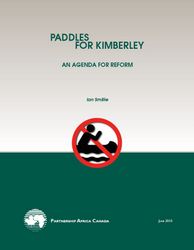
Paddles for Kimberley: An Agenda for Reform
June 2010
This report explores the many challenges faced by the Kimberley Process, including the obstacles posed by an annually rotating chair, particularly organizational memory; alternatives to the current consensus based decision-making process; follow up to review missions; making human rights language and protection more explicit in KP minimum requirements; and challenges enforcing internal controls.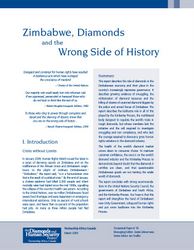
Zimbabwe, Diamonds and the Wrong Side of History
March 2009
This report describes the role of diamonds in the Zimbabwean economy and their place in the country's increasingly repressive governance. It describes growing evidence of smuggling, the militarization of diamond resources and the killing of dozens of unarmed diamond diggers by the armed forces of Zimbabwe. The report describes the lacklustre role in all of this played by the Kimberley Process, and it asks the United Nations Security Council to step in.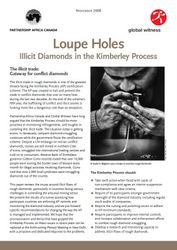
Loupe Holes: Illicit Diamonds in the Kimberley Process
November 2008
As the Kimberley Process (KP) rough diamond certification scheme’s sixth year drew to a close at the end of 2008, the trafficking in conflict and illicit stones looked more like a dangerous rule than an exception. In a joint report issued before the November 2008 KP Plenary Meeting in New Delhi, Global Witness and Partnership Africa Canada warned that the illicit trade in rough diamonds is one of the greatest threats facing the Kimberley Process. The report called for specific action by the Kimberley Process and the 76 governments that have agreed to its minimum standards.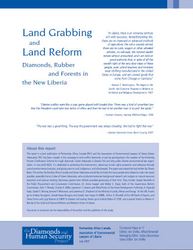
Land Grabbing and Land Reform: Diamonds, Rubber and Forests in the New Liberia
July 2007
This report, co-published by PAC and Green Advocates in Monrovia, describes Liberia’s timber, rubber and diamond sectors. It lays out what must be done by the Liberian government and civil society, as well as the donor agencies, companies and NGOs that work there, to make certain that there is no return to the old pre-war ways of doing things, and to ensure that the country’s natural resources are used for the benefit of all Liberians, now and in the future.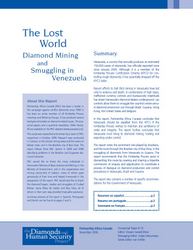
The Lost World: Diamond Mining and Smuggling in Venezuela
November 2006
This report on the diamond mining industry of Venezuela documents how and why Venezuela’s diamonds – an industry that produces from 150,000 to 200,000 carats per year, worth as much as US$20 million annually – have been driven underground. PAC further details the inability of Venezuela’s Ministry of Basic Industry and Mining (Miban) to control the diamond trade, officially ignoring the problem, while official diamond exports dwindled to nothing.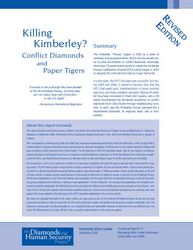
Killing Kimberley? Conflict Diamonds and Paper Tigers
November 2006
This report was written in advance of the November 2006 Kimberley annual meeting in Gaborone Botswana, to help convince governments and industry that change was needed. It worked. The paper, however, remains unchanged for the historical record, with the exception of Page 1, which explains briefly how almost everything demanded in Killing Kimberley? was accepted by industry and the 70-odd governments represented at the meeting.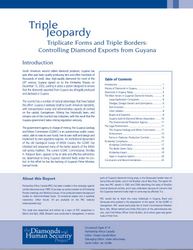
Triple Jeopardy - Triplicate Forms and Triple Borders: Controlling Diamond Exports from Guyana
April 2006
In this report, Partnership Africa Canada reveals an illegal tri-border diamond smuggling system, operating completely outside the international Kimberley Process Certification Scheme (KPCS) for rough diamonds. It tells the story of Guyana’s diamonds, worth an estimated US$43 million annually.
Fugitives and Phantoms: The Diamond Exporters of Brazil
March 2006
Brazil is one of the oldest diamond producing countries in the world, but nobody can say where half of the diamonds it exports have been mined, and government certificates accompanying fully one quarter of Brazilian exports are fraudulent. The PAC report demonstrates that Brazil’s diamond sector is in deep crisis, a crisis that affects the credibility of the newly-minted global system to block trade in the conflict diamonds that fuelled four of Africa’s most horrific wars. Also available in Portuguese.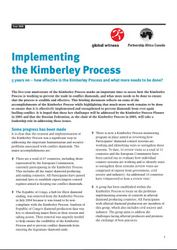
Implementing the Kimberley Process: 5 years how effective is the Kimberley Process and what more needs to be done?
June 2005
Five years after its creation the Kimberley Process, the international diamond certification scheme, is still having difficulty stopping conflict diamonds from entering the legitimate trade. Global Witness and Partnership Africa Canada are urging that more must be done to ensure that the process works effectively and is a credible mechanism that will prevent diamonds from ever again fuelling conflict. Diamonds continue to fuel conflict in eastern DRC and are also playing a role in the conflict in Côte d’Ivoire, two countries participating in the Kimberley Process.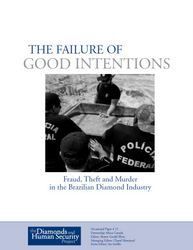
The Failure of Good Intentions
May 2005
This report is a detective story. It is about fraud and theft and murder, and good intentions gone wrong. Brazil has a long history of diamond production, and is the largest diamond producing country in South America. Brazilian diamonds have attracted a wide variety of exploration and mining firms, as well as the usual complement of international buyers and soldiers of fortune. The massacre of 29 diamond diggers on the Roosevelt Indian Reserve in the remote Rondônia rainforest in 2004 attracted international media attention and demonstrated that conflict diamonds are by no means restricted to Africa. Also available in Portuguese.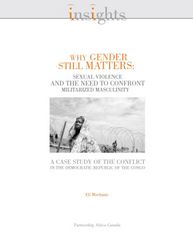
Why Gender Still Matters: Sexual violence and the need to confront militarized masculinity
December 2004
The war in the Democratic Republic of the Congo (DRC) was marked by almost unimaginable atrocities, including millions killed and displaced in a war that seven nations have participated in. Most horrifically, sexual assault became a major part of the violence with rape being so systematic and brutal that doctors in the DRC are now classifying wounds inflicted by rapists as combat injuries. This report delves into the gendered dimensions of war in the DRC.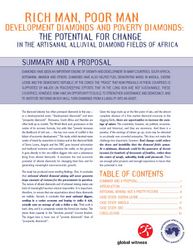
Rich Man, Poor Man – Development Diamonds and Poverty Diamonds: The Potential for Change in the Artisanal Alluvial Diamond Fields of Africa
October 2004
Rich Man Poor Man reports on months of research in the diamond fields of Sierra Leone, Angola and the Congo. There, alluvial diamonds represent the primary source of income for more than one million freelance diggers and their families. On average, however, they earn only a dollar a day. Working conditions are unhealthy and dangerous; cheating, theft and smuggling are rampant.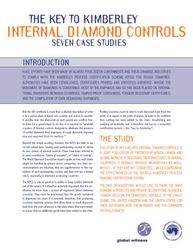
The Key to Kimberley: Internal Diamond Controls - Seven Case Studies
October 2004
The report examines the implementation of new control systems in Belgium, Britain, the United States, Canada, Angola, Ghana and the Democratic Republic of the Congo. The report recognizes the strengths of the Belgian system if implemented fully but is critical of US, British and Canadian regulations because of weak or non-existent government audits of companies dealing with diamonds. The report is much more critical of controls in the Congo and Angola, however. The report recommends much tougher oversight if illicit diamonds are to be excluded from the legitimate diamond trade.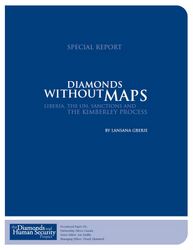
Diamonds Without Maps: Liberia, the UN, Sanctions and the Kimberley Process
June 2004
This Report warns that the UN Security Council should not lift its 2001 embargo on Liberian diamonds until the country has an effective diamond control mechanism in place. Diamonds have been at the centre of West Africa’s nightmare for more than a decade.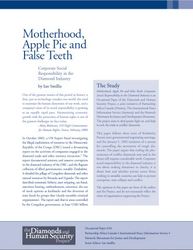
Motherhood, Apple Pie and False Teeth: Corporate Social Responsibility in the Diamond Industry
June 2003
This report argues that ending the phenomenon of conflict diamonds now and in the future still requires considerable work. Corporate social responsibility in the diamond industry is not about making donations to charity; it is about how and whether private sector firms can help to prevent corruption, state collapse and war.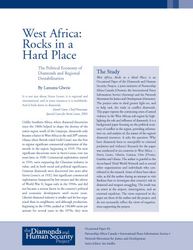
West Africa: Rocks in a Hard Place. The Political Economy of Diamonds and Regional Destabilization
May 2003
This report exposes the continuing crises of armed violence in the West African sub-region by highlighting the role and influence of diamonds and concludes with recommendations for the UN Security Council and the Kimberley Process.
Diamonds in the Central African Republic: Trading, Valuing and Laundering
January 2003
This report discusses the strong likelihood that conflict diamonds from the Democratic Republic of the Congo and elsewhere are being laundered through the Central African Republic. Concludes with recommendations for the government of the CAR and for the Kimberley Process.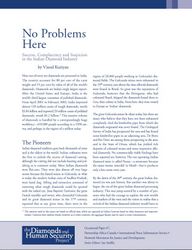
No Problems Here: Success, Complacency and Suspicion in the Indian Diamond Industry
December 2002
This report examines the Indian diamond industry, the world's major cutting and polishing centre. While the report finds no direct evidence of conflict diamonds in India, it concludes that the Indian diamond industry - like others - must ensure that effective international mechanisms are implemented to stop the trade in conflict diamonds.
War and Peace in Sierra Leone: Diamonds, Corruption and the Lebanese Connection
November 2002
Provides an overview and analysis of the situation in Sierra Leone with respect to the diamond industry since the UN intervention in 2000 and examines the role of Sierra Leone's Lebanese community in the diamond industry.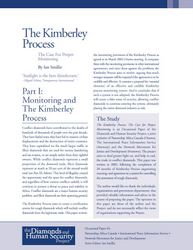
The Kimberley Process: The Case for Proper Monitoring
September 2002
Assesses the effectiveness of the proposed Kimberley Process certification scheme for rough diamonds to halt the trade in conflict diamonds. The paper concludes that without regular independent monitoring of all national control systems, the Kimberley Process will create a false sense of security, ultimately placing the entire diamond industry at risk.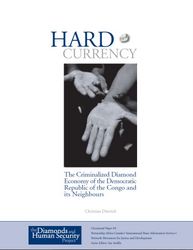
Hard Currency: The Criminalized Diamond Economy of the Democratic Republic of Congo and its Neighbours
June 2002
This report links the wars in Angola and the Congo, along with other conflicts in Central Africa, to the massive illicit trade in conflict diamonds. Concludes with recommendations for countries in Central Africa, the United Nations, the Kimberley Process and donor agencies.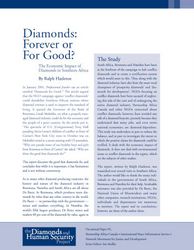
Diamonds: Forever or for Good? The Economic Impact of Diamonds in South Africa
March 2002
The report investigates the extent to which diamonds contribute to development in South Africa, Namibia and Botswana, countries which have been the most vocal champions of “prosperity diamonds” or “diamonds for development”.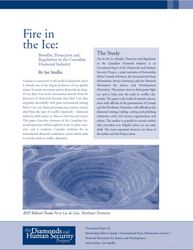
Fire in the Ice: Benefits, Protection and Regulation in the Canadian Diamond Industry
January 2002
A report on the emerging diamond industry in Canada, specifically in the Northwest Territories; describes elements of the Canadian diamond experience which might be of use in other countries, and examines Canada’s readiness for an international diamond certification system. The report concludes with recommendations for governments in Canada.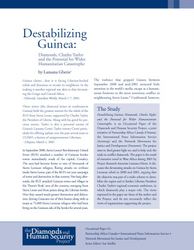
Destablizing Guinea: Diamonds, Charles Taylor and the Potential for Wider Humanitarian Catastrophe
October 2001
This report traces the development of Guinea's diamond industry and discusses the devastating attacks by Sierra Leonean rebels in 2000 and 2001, arguing that the objective was part of a wider scheme to destabilize the region and to further Liberian President Charles Taylor's regional economic ambitions.
